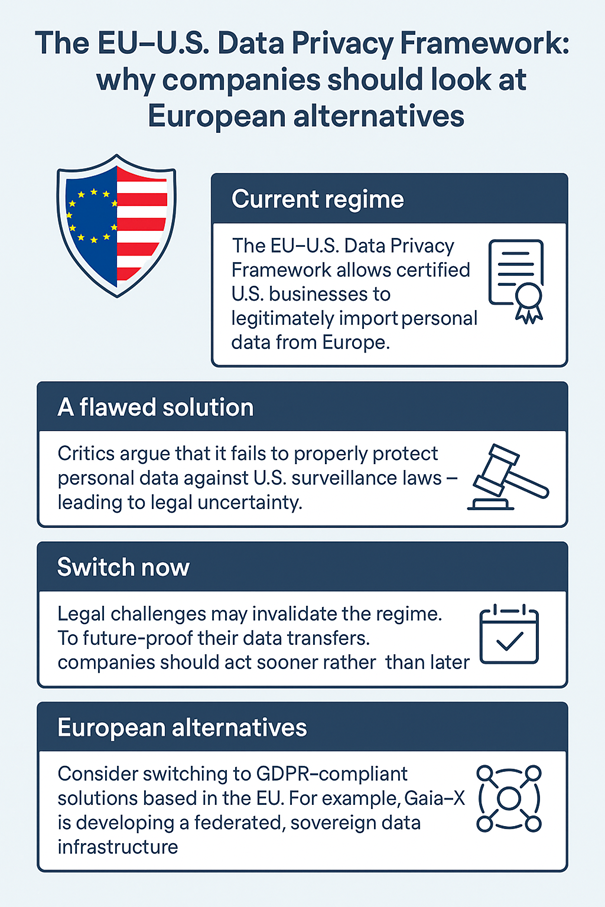1. Data protection is not optional
In the European Union, privacy is a fundamental right. The GDPR sets strict conditions for processing and transferring personal data, especially when it leaves the EU. In recent years, the European Court of Justice has overturned multiple transfer frameworks with the United States: first Safe Harbor (2015), then Privacy Shield (2020).
Why? Because US surveillance laws do not offer sufficient protection for EU citizens. Despite that, many organizations today rely on a new certification system: the EU–US Data Privacy Framework.
But that trust is shaky.
2. What is the Data Privacy Framework?
Introduced in 2023, the EU–US Data Privacy Framework replaces Privacy Shield. It allows US companies to self-certify against a set of privacy principles. In return, EU-based companies may legally transfer personal data to them.
On paper, it looks like a stable solution. In practice, its legal foundation is still fragile.

3. The weak spots in the new model
The core issues from previous frameworks remain unresolved:
- US law still permits broad surveillance. Laws like FISA 702 and the CLOUD Act allow US authorities to access data, even when stored outside the US.
- Legal redress is limited. EU citizens have no effective way to challenge US government access to their data.
- Privacy authorities remain skeptical. Both the European Data Protection Board (EDPB) and privacy group NOYB argue that the framework is too similar to the previous (invalidated) ones.
4. High risk of the court striking it down again
Privacy activist Max Schrems and his organization NOYB have already announced they will challenge the framework in court, again. The core arguments remain the same: lack of legal safeguards and inadequate protection from surveillance.
This isn’t a question of if the framework will fall, but when. Organizations that rely on it today may soon find their data transfers are suddenly illegal under the GDPR.
5. Waiting is not a strategy
Do you use US-based software, cloud services or analytics tools? Then now is the time to act,not after the legal foundation collapses.
Once the framework is invalidated, your legal basis disappears. That creates immediate risk of enforcement, fines and reputational damage.
What you should do now:
- Map which tools transfer data to the US
- Review your safeguards (SCCs, encryption, access control)
- Investigate alternatives that operate fully under EU law
6. Strong European alternatives already exist
The European tech ecosystem has matured. For nearly every US-based tool, a privacy-friendly alternative now exists, hosted entirely within the EU and subject to EU jurisdiction.
| Application | European alternatives |
|---|---|
| Cloud storage & hosting | OVHcloud (FR), Hetzner (DE), Scaleway (FR) |
| Collaboration & productivity | Nextcloud (DE), ONLYOFFICE (LV) |
| Email & communication | Proton (CH), Tutanota (DE), Element (Matrix) |
| Analytics & marketing | Matomo (DE), Piwik PRO (PL), Plausible (EE) |
If GDPR compliance is a priority for your business, these tools are the obvious choice.
7. Gaia-X: the European path to digital sovereignty
Beyond individual tools, Europe is building a long-term structural solution: Gaia-X.
What is Gaia-X?
A federated cloud infrastructure designed to comply with the strictest requirements for data privacy, security and interoperability. All services are designed to be GDPR-compliant and operated under EU control.
Examples include:
- Structura-X: a European cloud infrastructure alliance
- Sovereign Cloud Stack: an open-source cloud architecture
By choosing Gaia-X partners, organizations lay the groundwork for true data sovereignty.
8. Conclusion: don’t wait for legal collapse, act now
History repeats itself. Legal arrangements with the US have repeatedly failed. Organizations that place blind trust in the new framework risk being caught off guard again.
What you can do today:
- Conduct a DPIA (Data Protection Impact Assessment)
- Map your risks and international data flows
- Prepare for the future by switching to European providers
✅ RealCob gives you instant insight into your international data flows
Want to see which of your tools transfer data outside the EU? RealCob helps you:
- Automatically map international transfers
- Generate DPIAs with structured templates
- Identify legal risks in your tool landscape

